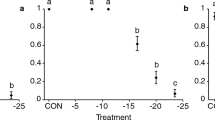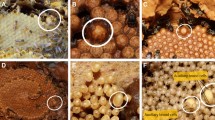Abstract
Comparisons of “time of mating” (the time copulation begins) between lines selected for short and long developmental periods have been made in the melon fly, Bactrocera cucurbitae. These comparisons showed that longer developmental periods were associated with later initiation of mating. Crosses were also made between selected lines to ascertain the genetic basis of developmental period and time of mating. Comparisons of daily activity rhythms for four types of behavior (locomotion, preening, feeding, and wing vibration) between the selected lines showed the following; (1) locomotion and preening occurred in daytime for the short developmental period lines, versus mainly at night for the long developmental period lines; (2) feeding behavior occurred in daytime for both the short and the long developmental period lines; and (3) wing vibration, a component of courtship behavior of males, occurred at dusk for the short developmental period lines and at night for the long developmental period lines.
Similar content being viewed by others
REFERENCES
Arakaki, N., Kuba, H., and Soemori, H. (1984). Mating behavior of the oriental fruit fly, Dacus dorsalis Hendel (Diptera: Tephritidae). Appl. Entomol. Zool. 19:42–51.
Bell, G., and Koufopanou, V. (1986). The cost of reproduction. Oxford Surv. Ecol. Biol. 3:83–131.
De Lima, I. S., Howse, P. E., and Salles, A. B. (1994). Reproductive behaviour of the south American fruit fly Anastrepha fraterculus (Diptera: Tephritidae): Laboratory and field studies. Physiol. Entomol. 19:271–277.
Drew, R. A. I. (1989). The taxonomy and distribution of tropical and subtropical Dacinae. In Robinson, A. S., and Hooper, G. (eds.), Fruit Flies: Their Biology, Natural Enemies and Control, Vol. 3A, Elsevier, Oxford, pp. 9–14.
Falconer, D. S. (1989). Introduction to Quantitative Genetics, 3rd ed., Longman, England.
Fitt, G. P. (1981a). Responses of female dacinae to “male” lures and their relationship to patterns of mating behaviour and pheromone response. Entomol. Exp. Appl. 29:87–97.
Fitt, G. P. (1981b). Inter-and intraspecific responses to sex pheromones in laboratory bioassays by females of three species of Tephritid fruit flies from northern Australia. Entomol. Exp. Appl. 30:40–44.
Foote, R. H., Blanc, F. L., and Norrbom, A. L. (1993). Handbook of the Fruit Flies (Diptera: Tephritidae) of America North of Mexico, Cornell University Press, Ithaca, NY.
Graves, J. L., Luckinbill, L. S., and Nichols, A. (1988). A flight duration and wing beat frequency in long-and short-lived Drosophila melanogaster. J. Insect Physiol. 34:1021–1026.
Hall, J. C. (1995). Tripping along the trail to the molecular mechanisms of biological clocks. Trends Neurosci. 18:230–240.
Hill, W. G., and Caballero, A. (1992). Artificial selection experiments. Annu. Rev. Ecol. Syst. 23:287–310.
Hillesheim, E., and Stearns, S. C. (1991). The responses of Drosophila melanogaster to artificial selection on body weight and its phenotypic plasticity in two larval food environments. Evolution 45:1909–1923.
Hoffmann, A. A., and Parsons, P. A. (1991). Evolutionary Genetics and Environmental Stress, Oxford University Press, New York.
Hudak, M. J., and Gromko, M. H. (1989). Response to selection for early and late development of sexual maturity in Drosophila melanogaster. Anim. Behav. 38:344–351.
Iwahashi, O., and Majima, T. (1986). Lek formation and male-male competition in the melon fly, Dacus cucurbitae Coquillett (Diptera: Tephritidae). Appl. Entomol. Zool. 21:70–75.
Kakinohana, H. (1994). The melon fly eradication program in Japan. In Calkins, C. O., Klassen, W., and Liedo, P. (eds.), Fruit Flies and the Sterile Insect Technique, CRC Press, Boca Raton, FL, pp. 223–236.
Kakinohana, H. (1996). Studies on the mass production of the melon flies, Bactrocera cucurbitae Coquillett. Bull. Okinawa Agr. Exp. Sta. 16:1–102 (in Japanese with English summary).
Konopka, R. J., and Benzer, S. (1971). Clock mutants of Drosophila melanogaster. Proc. Natl. Acad. Sci. USA 68:2112–2116.
Koyama, J., Nakamori, H., and Kuba, H. (1986). Mating behavior of wild and mass-reared strains of the melon fly, Dacus cucurbitae Coquillett (Diptera: Tephritidae), in a field cage. Appl. Entomol. Zool. 21:203–209.
Kuba, H., and Itô, Y. (1993). Remating inhibition in the melon fly, Bactrocera (=Dacus) cucurbitae (Diptera: Tephritidae): Copulation with spermless males inhibits female remating. J. Ethol. 11:23–28.
Kuba, H., and Koyama, J. (1982). Mating behavior of the melon fly, Dacus cucurbitae Coquillett (Diptera: Tephritidae): Comparative studies of one wild and two laboratory strains. Appl. Entomol. Zool. 17:559–568.
Kuba, H., and Koyama, J. (1985). Mating behavior of wild melon flies, Dacus cucurbitae Coquillett (Diptera: Tephritidae) in a field cage: Courtship behavior. Appl. Entomol. Zool. 20:365–372.
Kuba, H., and Soemori, H. (1988). Characteristics of copulation duration, hatchability of eggs and remating intervals in the melon fly, Dacus cucurbitae Coquillett (Diptera: Tephritidae). Jpn. J. Appl. Entomol. Zool. 32:321–324 (in Japanese with English summary).
Kuba, H., Koyama, J., and Prokopy, R. J. (1984). Mating behavior of wild melon flies, Dacus cucurbitae Coquillet (Diptera: Tephritidae), in a field cages: Distribution and behavior of flies. Appl. Entomol. Zool. 19:367–373.
Kyriacou, C. P., Oldroyd, M., Wood, J., Sharp, M., and Hill, M. (1990). Clock mutations alter developmental timing in Drosophila. Heredity 64:395–401.
Landolt, P. J., and Hendrichs, J. (1983). Reproductive behaviour of the papaya fruit fly, Toxotrypana curvicauda Gerstaecker (Diptera: Tephritidae). Ann. Entomol. Soc. Am. 76:413–417.
Miyatake, T. (1993). Difference in the larval and pupal periods between mass-reared and wild strains of the melon fly, Bactrocera cucurbitae (Coquillett) (Diptera: Tephritidae). Appl. Entomol. Zool. 28:577–581.
Miyatake, T. (1995). Two-way artificial selection for developmental period in Bactrocera cucurbitae (Diptera: Tephritidae). Ann. Entomol. Soc. Am. 88:848–855.
Miyatake, T. (1996). Comparison of adult life history traits in lines artificially selected for long and short larval and pupal developmental periods in the melon fly, Bactrocera cucurbitae (Diptera: Tephritidae). Appl. Entomol. Zool. 31:335–343.
Miyatake, T., and Haraguchi, D. (1996). Mating success in Bactrocera cucurbitae (Diptera: Tephritidae) under different rearing densities. Ann. Entomol. Soc. Am. 89:284–289.
Miyatake, T., and Yamagishi, M. (1993). Active quality control in mass reared melon flies: Quantitative genetic aspects. In Management of Insect Pests: Nuclear and Related Molecular and Genetic Techniques, IAEA, Vienna, pp. 201–213.
Nakamori, H., and Kakinohana, H. (1980). Mass-production of the melon fly, Dacus cucurbitae Coquillett, in Okinawa, Japan. Rev. Plant Prot. Res. 13:37–53.
Nakamori, H., Kakinohana, H., and Yamagishi, M. (1992). Automated mass production system for fruit flies based on the melon fly, Dacus cucurbitae Coquillett (Diptera: Tephritidae). In Anderson, T. E., and Leppla, N. C. (eds.), Advances in Insect Rearing for Research and Pest Management, Westview Press, Oxford, pp. 441–454.
Nielsen, J., Peixoto, A. A., Piccin, A., Costa, R., Kyriacou, C. P., and Chlmers, D. (1994). Big flies, small repeats: The “Thr-Gly” region of the period gene in Diptera. Mol. Biol. Evol. 11:839–853.
Nunney, L. (1996). The response to selection for fast larval development in Drosophila melanogaster and its effect on adult weight: An example of a fitness trade-off. Evolution 50:1193–1204.
Partridge, L., and Fowler, K. (1992). Direct and correlated responses to selection on age at reproduction in Drosophila melanogaster. Evolution 46:76–91.
Partridge, L., and Fowler, K. (1993). Responses and correlated responses to artificial selection on thorax length in Drosophila melanogaster. Evolution 47:213–226.
Prokopy, R. J., and Hendrichs, J. (1979). Mating behaviour of Ceratitis capitata on a field-caged host tree. Ann. Entomol. Soc. Am. 72:642–648.
Prokopy, R. J., Bennett, E. W., and Bush, G. L. (1972). Mating behaviour in Rhagoletis pomonella. II. Temporal organization. Can. Entomol. 104:97–104.
Reppert, S. M., Tsai, T., Roca, A. L., and Sauman, I. (1994). Cloning of a structural and functional homolog of the circadian clock gene period from the giant silkmoth Antheraea pernyi. Neuron 13:1167–1176.
Robacker, D. C., Mangan, R. L., Moreno, D. S., and Tarshis Moreno, A. M. (1991). Mating behavior and male mating success in wild Anastrepha ludens (Diptera: Tephritidae) on a field caged host tree. J. Insect Behav. 4:471–487.
Robertson, F. W. (1963). The ecological genetics of growth in Drosophila. 6. The genetic correlation between the duration of the larval period and body size in relation to larval diet. Genet. Res. Cambr. 4:74–92.
Shimizu, T., Miyatake, T., Watari, Y., and Arai, T. (1997). A gene pleiotropically controlling developmental and circadian periods in the melon fly, Bactrocera cucurbitae (Diptera: Tephritidae). Heredity 79 (in press).
Smith, P. H. (1989). Behavioural partitioning of the day and circadian rhythmicity. In Robinson, A. S., and Hooper, G. (eds.), Fruit Flies: Their Biology, Natural Enemies and Control, Vol. 3B, Elsevier, Oxford, pp. 325–341.
Stearns, S. C. (1992). The Evolution of Life Histories, Oxford University Press, New York.
Suenaga, H. (1991). Correlated responses of mating behavior of Dacus cucurbitae to selections for early and late reproduction or short and long larval period. In Kawasaki, K., Iwahashi, O., and Kaneshiro, K. Y. (eds.), Proceedings of the International Symposium on the Biology and Control of Fruit Flies, Okinawa Prefecture, Ginowan, Japan, pp. 327–330.
Suzuki, Y., and Koyama, J. (1980). Temporal aspects of mating behavior of the melon fly, Dacus cucurbitae Coquillett (Diptera: Tephritidae): A comparison between laboratory and wild strains. Appl. Entomol. Zool. 15:215–224.
Yamagishi, M., and Tsubaki, Y. (1990). Copulation duration and sperm transfer in the melon fly, Dacus cucurbitae Coquillett (Diptera: Tephritidae). Appl. Entomol. Zool. 25:517–519.
Zervas, G. A., and Economopoulos, A. P. (1982). Mating frequency in caged populations of wild and artificially reared (normal or γ-sterilized) olive fruit flies. Environ. Entomol. 11:17–20.
Zwaan, B., Bijlsma, R., and Hoekstra, R. F. (1995). Artificial selection for developmental time in Drosophila melanogaster in relation to the evolution of aging: Direct and correlated responses. Evolution 49:635–648.
Author information
Authors and Affiliations
Additional information
until June 1998 t.miyatake@ucl.ac.uk
Rights and permissions
About this article
Cite this article
Miyatake, T. Correlated Responses to Selection for Developmental Period in Bactrocera cucurbitae (Diptera: Tephritidae): Time of Mating and Daily Activity Rhythms. Behav Genet 27, 489–498 (1997). https://doi.org/10.1023/A:1025682618895
Issue Date:
DOI: https://doi.org/10.1023/A:1025682618895




